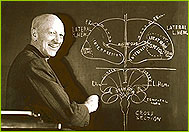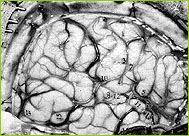|

|

|
|
Brain-Mapping Pioneers
What would you do if you were a doctor and had patients who
were missing pieces of their skulls? If you were Eduard
Hitzig, a German doctor working at a military hospital in
the 1860s, you'd conduct some experiments. Hitzig, working
on patients who had pieces of their skulls blown away in
battle, stimulated exposed brains with wires connected to a
battery. By doing so, he discovered that weak electric
shocks, when applied to areas at the back of the brain,
caused the patients' eyes to move.
|
 Wilder Penfield, a pioneering brain surgeon, mapped
the motor cortex using mild electric current.
Wilder Penfield, a pioneering brain surgeon, mapped
the motor cortex using mild electric current.
|
Later, around 1870, Hitzig teamed up with another doctor,
Gustav Fritsch. Setting up a makeshift lab in Fritsch's
house, the two stimulated the brains of live dogs. They
found that not only could they cause crude movements of the
dogs' bodies, but that specific areas of the brain
controlled specific movements.
John Hughlings Jackson, an English scientist, soon after
took the work of Fritsch and Hitzig even further. Based on
his observations of his wife's epileptic seizures, Jackson
came up with a more detailed theory of how the brain
controls muscles. He knew that every one of her seizures
followed the same pattern: It would start at one of her
hands, move to her wrist, then her shoulder, then her face.
It would finally affect the leg on the same side of her
body, then stop.
Jackson believed that the seizures were electrical
discharges within the brain. The discharges started at one
point and radiated out from that point. This suggested that
the brain was divided into different sections, and that each
section controlled the motor function (or movement) of a
different part of the body. And since the pattern never
varied, the way the brain is organized must also be set.
 A brain exposed during surgery.
A brain exposed during surgery.
|
|
Wilder Penfield took the next exploratory voyage into the
brain starting in the 1940s. While operating on epileptic
patients, Penfield applied electric currents to the surface
of patients' brains in order to find problem areas. Since
the patients were awake during the operations, they could
tell Penfield what they were experiencing. Probing some
areas triggered whole memory sequences. For one patient,
Penfield triggered a familiar song that sounded so clear,
the patient thought it was being played in the operating
room.
During these operations, Penfield watched for any movement
of the patients' bodies. From this information, he was able
to map the motor cortex, the very part of the brain you can
map in this feature's activity.
Probe the Brain
|
A Map of the Motor Cortex
Photos: (1) Princeton University Press; (2) Courtesy of
John Postlethwait.
Visual Mind Games
|
From Ramachandran's Notebook
|
The Electric Brain
|
Probe the Brain
Resources
|
Teacher's Guide
|
Transcript
|
Site Map
|
Secrets of the Mind Home
Search |
Site Map
|
Previously Featured
|
Schedule
|
Feedback |
Teachers |
Shop
Join Us/E-Mail
| About NOVA |
Editor's Picks
|
Watch NOVAs online
|
To print
PBS Online |
NOVA Online |
WGBH
©
| Updated October 2001
|
|
|
|